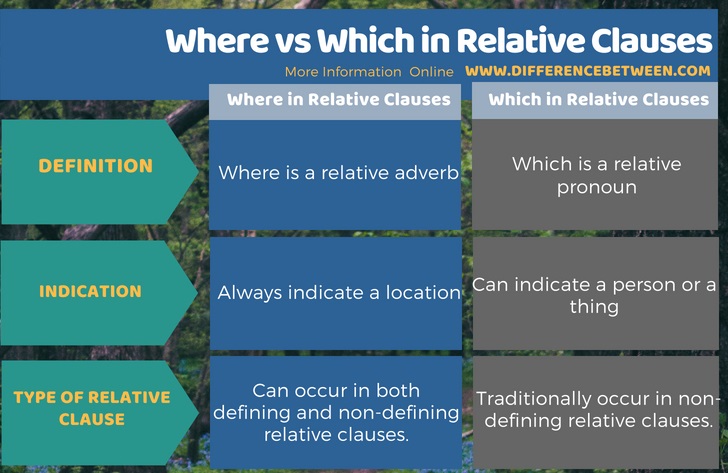Difference Between Where and Which in Relative Clauses
The key difference between where and which in relative clauses is that where in relative clauses always indicate a location whereas which can indicate a person or a thing.
Furthermore, Where is a relative adverb whereas which is a relative pronoun. However, you can use both of these words in a relative clause. But, the difference between where and which in relative clauses depends on the type of information they add to a sentence.
CONTENTS
1. Overview and Key Difference
2. What is a Relative Clause
3. How to use Where in Relative Clauses
4. How to use Which in Relative Clauses
5. Side by Side Comparison – Where vs Which in Relative Clauses in Tabular Form
6. Summary
What is a Relative Clause?
A relative clause is a type of dependent clause, which cannot stand alone in a sentence. It gives more information about the sentence and basically acts as an adjective. A relative clause usually begins with a relative pronoun. The most commonly used relative pronouns in the English language are who, that, and which. A relative pronoun in a relative clause usually substitutes a noun, noun phrase, or a pronoun. Given below are some examples of relative clauses.
He is wearing a shirt. I gave him that shirt. → He is wearing the shirt I gave him.
A man stole my wallet. He has been arrested. → The man who stole my wallet has been arrested.
There are two types of relative clauses as defining clauses and non-defining clauses.
Defining Clause
Defining clauses, also known as restrictive relative clauses or identifying relative clauses, add essential information to the sentence. It helps to identify a specific person or thing from a larger group. For example,
The students who do not study will fail the exam.
The accident that happened yesterday was the truck driver’s fault.
If you remove a defining relative clause from the sentence, the meaning of the sentence changes significantly. Moreover defining relative clause is not separated from the rest of the sentence by commas.
Non-Defining Clause
Non-defining clauses are the opposite of defining clauses. They add additional information to the sentence. Removing a non-defining clause will not change the overall meaning of a sentence. Moreover, they are always set off from the rest of the sentence by commas. For example,
My aunt, who was born in Paris, lived most of her life overseas.
He is always late, which is a really bad habit.
How to Use Where in Relative Clauses?
Where is a relative adverb, not a relative pronoun. However, it is sometimes used at the beginning of a relative clause. We use where in relative clauses to indicate a place.
The corner store, where we usually buy our food, was robbed.
This is the place where Lady Elizabeth was killed by highwaymen.
Baker Street is the street where Sherlock Holmes lived.

Figure 01: This is the village where we met.
We first met him in London, where we lived in the early eighties.
There is a site on the internet where you can download Classic movies.
Though he never married her, he built her a house where she lived and raised their son.
As seen from the above examples, where in a relative clause always refer to a place.
How to Use Which in Relative Clauses?
Which is a relative pronoun. In fact, it is one of the most used relative pronouns in a relative clause. Traditionally, this relative pronoun was used in the formation of non-defining relative clauses. As mentioned above, this type of relative clause gives additional information to a sentence. For example,
The festival, which lasted all day, ended with fireworks.
He has missed his bus, which means he is going to be late.

Figure 02: I made spaghetti, which is his favourite meal.
However, in modern usage, many people use this relative pronoun with defining clauses as well. Most people consider both uses grammatically correct. However, it is better to use the traditional grammar rule (which in the non-defining relative clause) in formal writing.
What is the Difference Between Where and Which in Relative Clauses?
Where is a relative adverb whereas which is a relative pronoun. However, we can use both of them to form a relative clause. Where in relative clauses always indicate a location whereas which can indicate a person or a thing. This is the key difference between where and which in relative clauses. Moreover, where can occur in both defining and non-defining relative clause. However, which mainly occur in a non-defining relative clause. The below infographic presents the difference between where and which in relative clauses in tabular form.

Summary – Where vs Which in Relative Clauses
Where is a relative adverb while which is a relative pronoun. The main difference between where and which in relative clauses is that where in relative clauses always indicate a location whereas which can indicate a person or a thing.
Image Courtesy:
1.”3205106″ by EllenChan (CC0) via pixabay
2.”660748″ by RitaE (CC0) via pixabay
ncG1vNJzZmivp6x7pbXFn5yrnZ6YsqOx07CcnqZemLyue8OinZ%2Bdopq7pLGMm5ytr5Wau27Dx56pnmWRo7Fuw8eimqFlmaN6s7HLmquirpVisK2t1KycrGc%3D